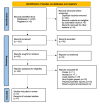The Management of Posterior Malleolus Fractures in Unstable Ankle Injuries: Where Do We Stand Now?
- PMID: 36620781
- PMCID: PMC9811151
- DOI: 10.7759/cureus.32191
The Management of Posterior Malleolus Fractures in Unstable Ankle Injuries: Where Do We Stand Now?
Abstract
The evaluation and treatment of the posterior malleolus fracture in unstable ankle injuries remain a topic of controversy. The main objective of this systematic review was to examine the available literature and identify the variables that affect the management of posterior malleolar fractures and how these are related to the outcomes. To that end, a systematic review was performed based on the Preferred Reporting Items for Systematic Reviews and Meta-Analyses (PRISMA) guidelines. A comprehensive search of MEDLINE, Embase, and Cochrane Library was conducted. The search terms used were as follows: "posterior malleolar", "ankle fractures", "trimalleolar fractures", "ORIF", "surgery", "operative", and "conservative". The available studies were screened against the inclusion and exclusion criteria. Based on the review of the available literature, we have concluded that the size of the posterior malleolar fragment is not an accurate indicator, and clinicians should consider other factors such as fracture configuration and articular surface congruity. Also, the risk for the development of post-traumatic arthritis increases when the joint surface is not restored regardless of the surgical intervention and fragment size. The complications of posterior malleolus fractures necessitate evidence-based management. The assessment and the final treatment of these injuries in unstable ankle fractures should not be based on the traditional fragment-size parameters. Clinicians should assess the fracture configuration through imaging modalities and try to preserve the articular surface congruity so as to achieve optimal outcomes. Finally, more studies with high-level evidence are required in order to determine the most appropriate management pathway for these patients.
Keywords: ankle fractures; conservative; operative; posterior malleolar; surgery; trimalleolar fractures.
Copyright © 2022, Serlis et al.
Conflict of interest statement
The authors have declared that no competing interests exist.
Figures
References
-
- P1-94 The epidemiology and costs of ankle injuries: a review of the literature. Bielska IA, Johnson A. J Epidemiol Community Health. 2011;65:3–7.
-
- Adult ankle fractures--an increasing problem? Court-Brown CM, McBirnie J, Wilson G. Acta Orthop Scand. 1998;69:43–47. - PubMed
-
- Surgical versus conservative interventions for treating ankle fractures in adults. Donken CC, Al-Khateeb H, Verhofstad MH, van Laarhoven CJ. Cochrane Database Syst Rev. 2012;1:0. - PubMed
-
- The treatment of trimalleolar fractures of the ankle. Nelson MC, Jensen NK. Surg Gynec Obst. 1940;71:509–551.
Publication types
LinkOut - more resources
Full Text Sources

